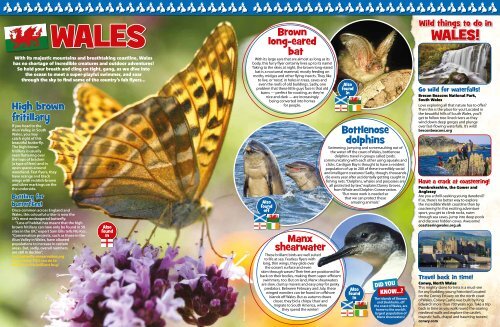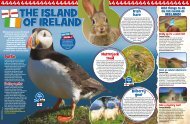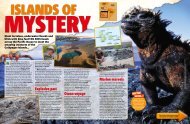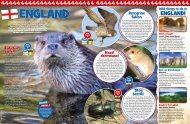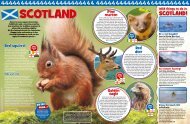88 NGKSUMM13wales.v3
- No tags were found...
You also want an ePaper? Increase the reach of your titles
YUMPU automatically turns print PDFs into web optimized ePapers that Google loves.
WALES<br />
With its majestic mountains and breathtaking coastline, Wales<br />
has no shortage of incredible creatures and outdoor adventures!<br />
So hold your breath and cling on tight, gang, as we dive into<br />
the ocean to meet a super-playful swimmer, and soar<br />
through the sky to find some of the country’s fab flyers...<br />
High brown<br />
fritillary<br />
If you head to the<br />
Alun Valley, in South<br />
Wales, you may<br />
catch sight of this<br />
beautiful butterfly.<br />
The high brown<br />
fritillary is usually<br />
seen fluttering over<br />
the tops of bracken<br />
(a type of fern) and in<br />
open spaces around<br />
woodland. Fast flyers, they<br />
have orange and black<br />
wings with reddish-brown<br />
and silver markings on the<br />
the underside.<br />
Battling for<br />
butterflies!<br />
Once common across England and<br />
Wales, this colourful critter is now the<br />
UK’s most endangered butterfly.<br />
“Loss of habitat has meant that the high<br />
brown fritillary can now only be found in 50<br />
sites in the UK,” expert Sam Ellis tells NG Kids.<br />
“Conservation projects, such as those in the<br />
Alun Valley in Wales, have allowed<br />
populations to increase in certain<br />
areas. But, sadly, overall numbers<br />
are still in decline”.<br />
Visit butterfly-conservation.org<br />
to see what YOU can do to<br />
help save this brilliant bug!<br />
Also<br />
found<br />
in<br />
Pictures: © Getty Images UK.<br />
Brown<br />
long-eared<br />
bat<br />
With its large ears that are almost as long as its<br />
body, this furry flyer certainly lives up to its name!<br />
Taking to the skies at night, the brown long-eared<br />
bat is a nocturnal mammal, mostly feeding on<br />
moths, midges and other flying insects. They like<br />
to live, or ‘roost’, in holes in trees, caves and<br />
even the roofs of old buildings. Sadly, one<br />
problem that these little guys face is that old<br />
barns — perfect for roosting, as they’re<br />
nice and dark — are increasingly<br />
being converted into homes<br />
for people.<br />
Manx<br />
shearwater<br />
These brilliant birds are well suited<br />
to life at sea. Fearless flyers with<br />
long, thin wings, they glide over<br />
the ocean’s surface and even<br />
skim through waves! Their feet are positioned far<br />
back on their bodies, making them super-efficient<br />
swimmers, too. But on land, Manx shearwaters<br />
are slow, clumsy movers and easy prey for pesky<br />
predators. Between February and July, these<br />
winged wonders can be found on offshore<br />
islands off Wales. But as autumn draws<br />
closer, they bid a chirpy ‘chao’ and<br />
migrate to South America, where<br />
they spend the winter!<br />
Bottlenose<br />
dolphins<br />
Swimming, jumping and somersaulting out of<br />
the water off the coast of Wales, bottlenose<br />
dolphins travel in groups called ‘pods’,<br />
communicating with each other using squeaks and<br />
clicks. Cardigan Bay is thought to have a resident<br />
population of up to 200 of these incredibly social<br />
and intelligent creatures! Sadly, though, thousands<br />
die every year after accidentally getting caught in<br />
fishing nets. “Dolphins, whales and porpoises are<br />
all protected by law,” explains Danny Groves,<br />
from Whale and Dolphin Conservation.<br />
“But more work is needed so<br />
that we can protect these<br />
amazing animals.”<br />
Wild things to do in<br />
WALES!<br />
Go wild for waterfalls!<br />
Brecon Beacons National Park,<br />
South Wales<br />
Love exploring all that nature has to offer?<br />
Then this is the place for you! Located in<br />
the beautiful hills of South Wales, you’ll<br />
get to follow tree-lined rivers as they<br />
wind down deep gorges and plunge<br />
over fast-flowing waterfalls. It’s wild!<br />
breconbeacons.org<br />
Have a crack at coasteering!<br />
Pembrokeshire, the Gower and<br />
Anglesey<br />
Are you a thrill-seeking young daredevil?<br />
If so, there’s no better way to explore<br />
the incredible Welsh coastline than by<br />
coasteering! In this exciting adventure<br />
sport, you get to climb rocks, swim<br />
through sea caves, jump into deep pools<br />
and discover hidden coves. Awesome!<br />
coasteeringwales.org.uk<br />
Travel back in time!<br />
Conwy, North Wales<br />
This mighty stone fortress is a must-see<br />
for any budding young historian! Located<br />
on the Conwy Estuary on the north coast<br />
of Wales, Conwy Castle was built by King<br />
Edward I more than 700 years ago. Take a trip<br />
back in time as you walk round the soaring<br />
medieval walls and explore the castle’s<br />
The islands of Skomer<br />
and Skokholm, off<br />
the coast of Wales, are<br />
home to the world’s<br />
largest population of<br />
Manx shearwaters! majestic halls, chapel and haunting towers!<br />
20 National Geographic Kids<br />
conwy.com ngkids.co.uk 21<br />
Also<br />
found<br />
off<br />
Also<br />
found<br />
in<br />
Also<br />
found<br />
in<br />
DID YOU<br />
KNOW...?


